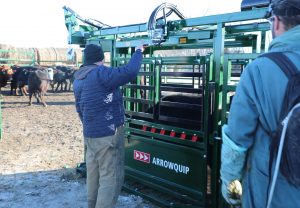 Here are some cattle winter handling tips sure to keep cattle and stock people safe and the ranch profitable over the coldest months of the year:
Here are some cattle winter handling tips sure to keep cattle and stock people safe and the ranch profitable over the coldest months of the year:
- Keep cattle dry and out of the wind. With the extreme weather conditions that cattle producers around North America face it is important to prevent cattle from becoming sick or injured. Hypothermia causes death in cattle. Keep cattle out of the wind and in a dry, warm spot to prevent hypothermia. Cattle should be moved inside if possible when temperatures fall below -40 degrees Fahrenheit.
- Keep cattle hydrated. Adequate hydration is essential to animal health in any season. Colder temperatures often cause decreased water consumption in livestock. Ensure fresh and clean drinking water is for cattle is also more challenging in freezing temperatures. Some cows adapt by eating the snow, but this is not an effective hydration strategy. Cattle must have a fresh and running water supply every day to prevent dehydration. Cattle that are dehydrated have behavioral issues that increase the risk of injury to handlers and other cattle.
- Maintain cattle handling equipment. Proper maintenance on cattle handling equipment is important in the winter months. Seasonal maintenance is recommended on all equipment, however proactive winter maintenance decreases risk of equipment malfunctions that lead to injury. Starting with the right equipment is the first step. Cattle handling equipment should be manufactured with the latest animal science research and to withstand weather and cattle working conditions. Chutes, alleys and loading chutes can become slippery in winter weather. Maintenance and cleaning can decrease injuries. Apply sand or salt and remove ice prior to using a handling system. Covering or moving a cattle handling system indoors can prevent snow and ice buildup and increase safety. Check all gates, latches, and chute mechanisms regularly and apply grease or perform maintenance as needed.
The joys and discomforts of agricultural life are present in all facets of the industry. The discomforts can be minimized during the winter months by keeping cattle dry and out of the wind, keeping cattle hydrated, and maintaining your cattle handling equipment. These practices will improve herd health, reduce safety risks, and increase the economic viability of your cattle operation.
Source: Arrowquip
